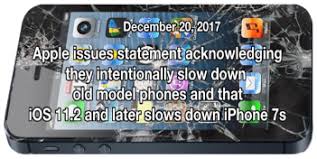|
At last estimate, there were about 45 Class Action lawsuits leveled at Apple over their "Battery Gate" fiasco. That does not include Apple's legal woes in other countries. This, combined with weak sales on the newer iPhone 8 and X models has many Apple stockholders deeply concerned. If you missed all of the excitement, we covered it in older blog posts. Several of my colleagues also explain the issues pretty well. Here are a few links that explain why Apple is in trouble with the government and their iPhone owners. Everyone with an iPhone 6, 6s or SE should immediately have Apple replace their batteries. Even if your phone has not exhibited battery problems, this will likely speed up your processor and undo Apple's throttling.
Apple quietly fixes battery glitch without notifying users. Apple stores overwhelmed for their $29 battery offer. Remember, this all came to light when a Reddit user discovered when replacing his original battery, his processing speed picked up substantially enough to notice. When Apple was confronted with this, they amazingly confessed. They did not come out and say that this was done to stimulate sales on newer models as many folks believe. Apple said the reason for the software feature was added was to prevent unexpected iPhone shutdowns, not to encourage users to update to a newer iPhone. They apparently figured that while a phone with this "software" will take longer to launch apps and would display lower frame rates, it would also be less likely to randomly reboot. "As we told our customers in December, we have never — and would never — do anything to intentionally shorten the life of any Apple product, or degrade the user experience to drive customer upgrades," Apple said in the statement. The next few months should prove interesting. Apple's legal problems with Qualcomm, their processor manufacturer, forced them to begin buying Intel Chips instead. I'm still puzzled as to why Apple would rely on their biggest rival, Samsung, to provide their AMOLED screen displays on the iPhone X and future models. These screens are far superior in brightness and resolution to Apple's old school LED displays. I'm no genius, but have some advice for Tim Cook. Everyone agrees that Apple's iOS, while not perfect is still the industry's standard. Unfortunately, probably for the reasons above, they have always lagged behind the Android camp as far as screen size, resolution, and processor speeds. Apple needs to go back to their bread and butter. The iPhone 4s/5s/SE chassis was definitely their best. It was pocket friendly and the best one-handed usage experience, bar none. The problem was these devices had a small 4" screen with enormous bezels blocking valuable space. I'd bring out a whole line of SE models. They could offer their current budget version which is an iPhone 6s in sheeps clothing (original 4s/5s/SE housing) as their leader model. A step up might be replacing the original screen with a bezel-less larger LCD screen and possibly the guts of the iPhone 7. The highest end SE model might feature the guts of the iPhone 8 or X, the same AMOLED screen but in 4s/5s/SE body style. Everyone is nostalgic and this would probably help Apple go after the low-medium price demographic. While I loved my iPhone 6 and 6s+, it was impossible to use them without a case. That's because the wider and thinner design meant danger and was sure to slide out of my hand. The newer models are more fragile, regardless of what Apple claims. All I put on my 5s model was a tempered glass screen saver I still have it sitting on my desk and it looks great.
0 Comments
Leave a Reply. |
Archives
March 2021
CategoriesAuthorJoel Saltzman has over twenty years of wireless industry experience. He is currently CEO and Chief Wireless Analyst for Dr Wireless. |



 RSS Feed
RSS Feed
